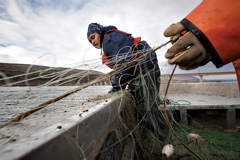forum
library
tutorial
contact

Harvest/River Managers Approve Tribal
Gillnet Fishery Above Bonneville Dam
by Staff
Columbia Basin Bulletin, May 22, 2015
|
the film forum library tutorial contact |

|
Harvest/River Managers Approve Tribal
by Staff
|
 The two-state Columbia River Compact, made up of Oregon and Washington fisheries managers, approved on Monday a gillnet spring fishery in Zone 6 (Bonneville through John Day pools) for treaty tribes.
The two-state Columbia River Compact, made up of Oregon and Washington fisheries managers, approved on Monday a gillnet spring fishery in Zone 6 (Bonneville through John Day pools) for treaty tribes.
The approved opening allows tribal gillnetters to take and sell salmon, steelhead, shad, carp, catfish, walleye, bass and yellow perch from reservoirs backed up behind Bonneville, The Dalles and John Day dams from 6 am Tuesday, May 19, to 6 pm Friday, May 22, a three and half day season. Legal-sized sturgeon can be kept for subsistence, but not sold.
In addition, the Technical Management Team, a regional team of fishery managers and hydroelectric dam operators, approved on Wednesday the tribes' System Operations Request 2015-C1 asking that the three reservoirs be operated to protect gillnets.
TMT Hydro operators agreed to limit Bonneville, The Dalles and John Day pool fluctuations to within a 1.5 foot band during the treaty fishery, and that they could extend the operation if the Compact approves a fishery next week. The Compact will meet again Tuesday, May 26, to determine, among other actions, if another treaty fishery would be allowed.
The treaty fishery was approved as large numbers of adult spring chinook salmon are counted at Bonneville Dam, with 187,360 spring chinook passing the dam as of May 18, and over 191,000 by May 20. The U.S. v Oregon Technical Advisory Committee is predicting the total spring chinook salmon run this year will top 250,000, with 235,000 of those salmon passing the dam.
Given TAC's run forecast, 10 percent of the fish, or 25,000, can be harvested, according to U.S. v Oregon. So far 15,916 fish have been taken through recreational, commercial and treaty fisheries, and an additional 2,000 fish are expected to be taken by platform fishers through June 15.
That leaves 7,084 fish for the other fisheries through June 15. The Columbia River Inter-Tribal Fish Commission expects 4,000 of those fish will be taken by treaty gillnetters.
After all the planned fisheries, CRITFC estimates that 3,084 salmon of the 25,000 spring chinook quota will remain.
Last week's treaty gillnet fishery was weak, according to Kyle Dittmer of CRITFC, with fewer gillnet fishers on the river than expected. Low flow and low pool levels, along with sea lion predation on the salmon impacted catch rates, he added.
Also last week, the Compact approved a 14-hour lower Columbia River non-Indian commercial driftnet fishery, restricting the gillnetters to tanglenets with a mesh size of 4.25 inches. That fishery, 4 pm Tuesday, May 12, to 6 am Wednesday, May 13, yielded 603 adult spring chinook salmon, with an average weight of 10.7 pounds, bringing the season total to 4,757 spring chinook taken by lower Columbia River commercial gillnetters. Gillnetters also took 124 jack salmon and 213 shad.
For the treaty fishery, CRITFC will monitor catch rates and fishing effort this week by conducting net counts from airplanes. 24-hour quick reporting is required of the treaty gillnetters. There are no restrictions on tribal gillnet mesh size and most fishers are using 8-inch mesh nets.
CRITFC, which represents four treaty tribes -- the Nez Perce Tribe, the Confederated Tribes of the Umatilla Indian Reservation, the Confederated Tribes of the Warm Springs Reservation of Oregon and the Confederated Tribes and Bands of the Yakama Nation -- said that keeping river conditions right for the spring treaty fishery has been the basis of litigation in the past. The operation, they said in the SOR, is "consistent with the trust and fiduciary responsibilities that the federal operators have with respect to CRITFC's member tribes."
CRITFC added in its SOR that good conditions during the fishery are "also consistent with the spirit of the 10-year Memorandum of Agreements signed by tribal and Corps, BPA, and USBR officials."
According to the SOR, a pool fluctuation greater than 1.5 feet creates several potential problems.
learn more on topics covered in the film
see the video
read the script
learn the songs
discussion forum
